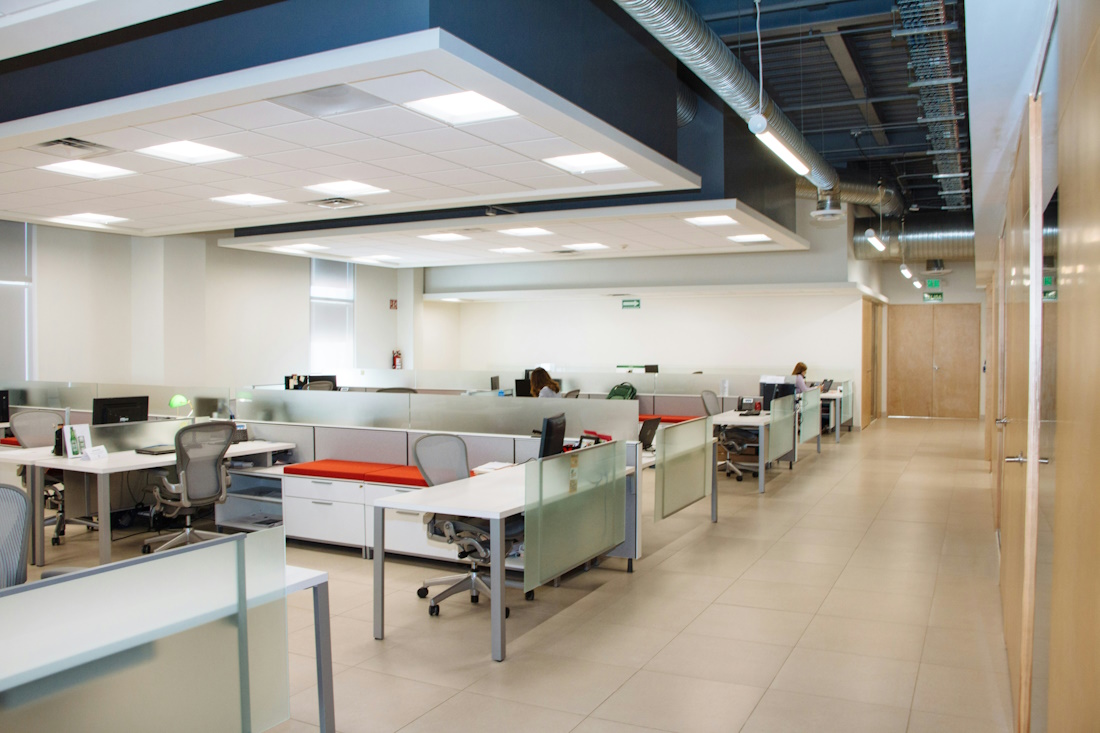In recent years, open-plan offices have become popular for businesses due to their communal and flexible seating arrangements.
These layouts typically have fewer interior walls than traditional workspaces, promoting collaboration. However, this can also result in less privacy for employees.
This article will explore 8 pros and cons of open-plan offices.
Pros
1. Facilitates Collaboration and Informal Learning
Open-plan offices can encourage informal interactions and conversations between employees. These layouts allow staff to approach one another spontaneously with questions or ideas, as walls or doors no longer separate them.
This makes it much easier for employees to learn from each other, understand new perspectives, and solve problems faster.

2. Improves Company Culture
Another benefit of renting open-plan workspaces is that they help develop meaningful relationships between coworkers. They build a sense of community, fostering a more vibrant company culture.
3. Improves Wellbeing
Working in an open space is also great for improving employee well-being. These offices promote a transparent and supportive environment where everyone feels included, reducing feelings of isolation and boredom.

4. Enhances Flexibility
Another benefit of open-plan layouts is their flexibility. They are great for businesses expecting shifts in workflow as they can accommodate varying team sizes and be adjusted to suit different projects.
Many organisations reconstruct their open-plan office to accommodate temporary teams and workstations as they aren’t restricted by fixed walls and rooms.
5. More Space
Open-plan offices provide more space than traditional layouts as they eliminate the need for individual cubicles, which take up a lot of floor space.
As a result, more workspaces and breakout areas can be integrated within the same square footage, enabling businesses to reduce their space requirements and cut costs.
6. Better Distribution of Natural Light
Workstations can be rearranged to improve the distribution of natural light throughout the office, creating a brighter environment.
Natural light significantly improves mood and productivity. It is visually appealing and boosts serotonin levels, alertness, and energy. It also reduces the need for artificial lighting, which can cause eye strain, saving money.

7. Easier Tech Integration
Another benefit of open-plan workspaces is that they make installing and maintaining new technology much easier.
Fewer physical barriers, like walls in the office, ensure seamless connectivity. This lets employees reliably access digital resources such as cloud computing and videoconferencing software, minimising downtime.
8. Easier Supervision
Additionally, these layouts make it easier to monitor staff.
Managers overseeing different projects simultaneously can quickly move between teams and identify problems, improving communication. They can also listen in on conversations in the background, providing real-time feedback.

Cons
1. More Noise/Distractions
A significant drawback of open-plan offices is that they can become noisy, distracting employees from focusing on individual tasks. With no walls or partitions to dampen conversations, noise easily travels throughout the space.
To help minimise this problem, we recommend noise-cancelling headphones.
2. Less Privacy
These open-plan layouts also result in little privacy for employees. Confidential conversations and working on sensitive tasks can be difficult without dedicated meeting rooms and offices.
Specific sectors, such as legal services, frequently hold private discussions and handle sensitive case details, which require closed meeting rooms/offices. Similarly, banking professionals deal with personal client data and transactions, making working in an open area difficult.

3. Security Concerns
In addition to reduced privacy, open workspaces can present security risks.
Sensitive documents and data are often stored on the desktops and desks of specific employees. Confidential documents can be inadvertently shared in open-plan offices, where workstations are frequently swapped.
This can make it more difficult to control access to sensitive information.
4. Lack of Personalisation
As these workspaces are uniform and shared, employees have fewer opportunities to personalise their desks. This can often lead to a sterile environment, making the office feel impersonal.
Employees can become less engaged at work without a sense of ownership and comfort from personalisation.

5. Higher Spread of Illness
Illnesses spread more easily in these types of offices. The proximity of employees in an open space facilitates the spread of viruses and germs as there are fewer barriers.
Due to the collaborative layout, employees sharing desks and keyboards are more likely to encounter contaminated resources. This can result in higher absenteeism rates, negatively impacting your business.
6. Leadership Issues Can Arise
Open layouts can result in leadership issues due to the lack of physical boundaries separating different levels of management.
In traditional workspaces, specific areas are dedicated to higher-ups, making it easy to identify managers and executives. This can become confusing in open-plan offices, where everyone works in the same shared space.

7. Difficulties with Temperature Control
Moreover, these offices present challenges with temperature control. Maintaining a constant temperature is much more difficult in large, open spaces, as it is often unevenly distributed. If the workspace has large windows, sunlight exposure can cause additional fluctuations.
Employees often have different preferences. Unreliable heating/cooling and the lack of walls make it difficult to meet their needs.
8. Issues Accommodating Diverse Work Styles
Businesses renting open-plan workspaces can struggle to accommodate diverse work styles. Some employees work best in busy settings where casual conversations occur frequently, while others may prefer to work in a quieter space with little to no distractions.
As employees share one large space, it can be challenging to create these different environments.
Open-plan offices boast several advantages, such as improved well-being and flexibility. Potential disadvantages like reduced privacy and personalisation may not be an issue depending on your organisational needs.
With the pros and cons listed in this article, you should better understand whether this layout fits your business.






